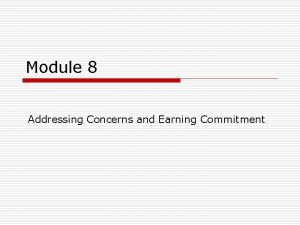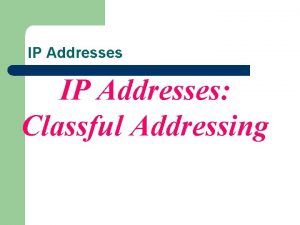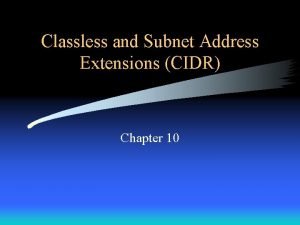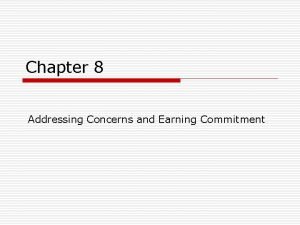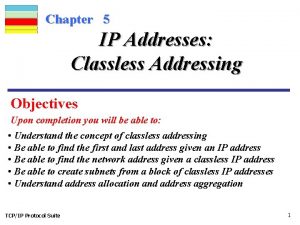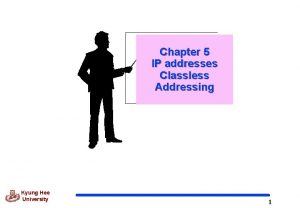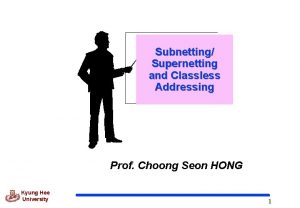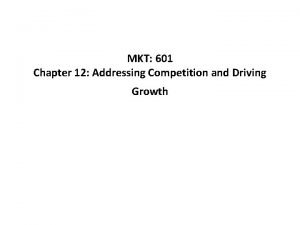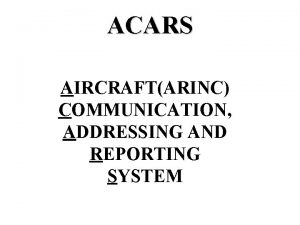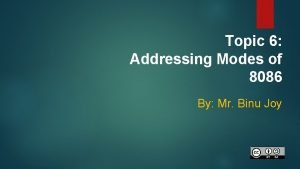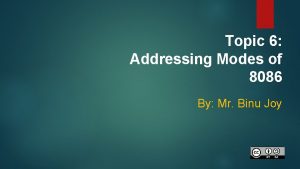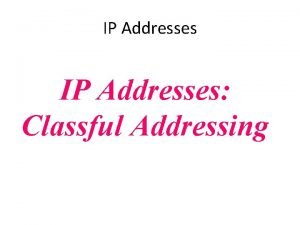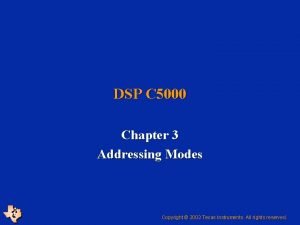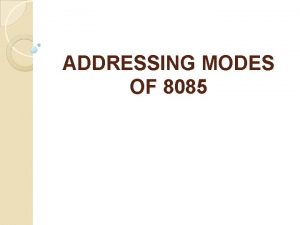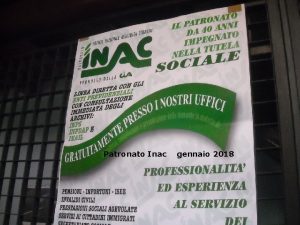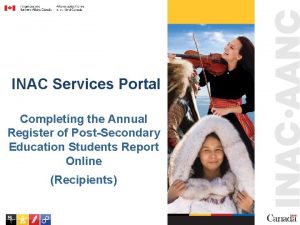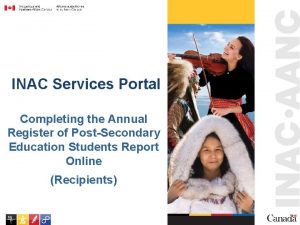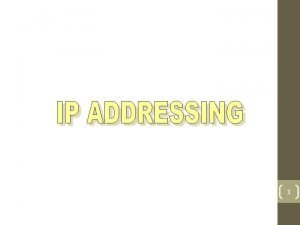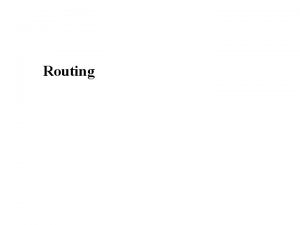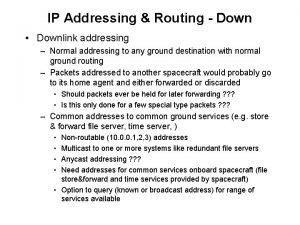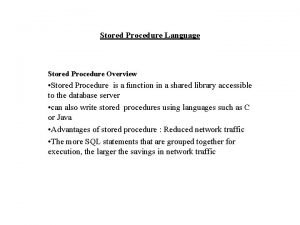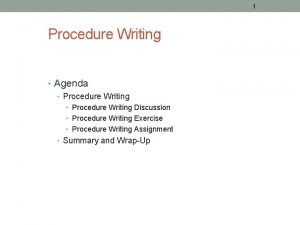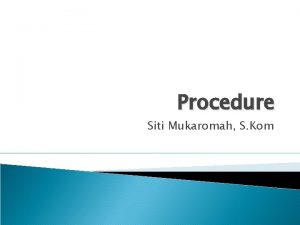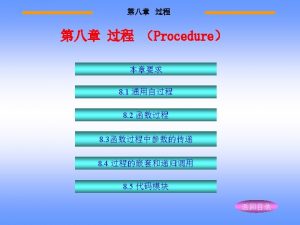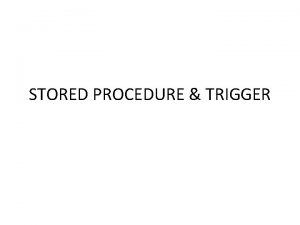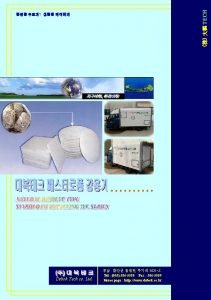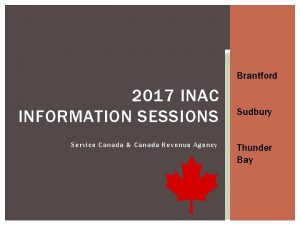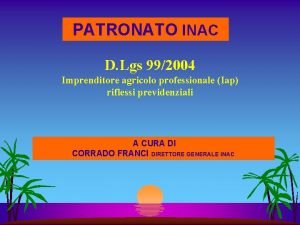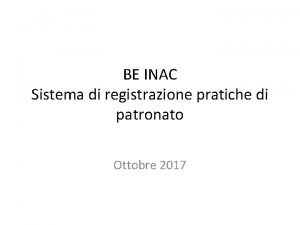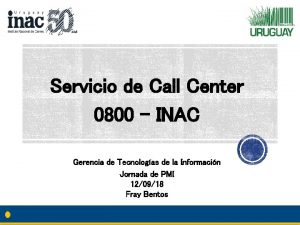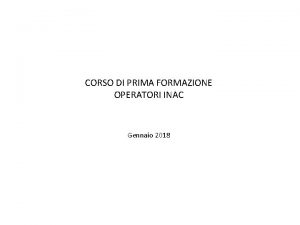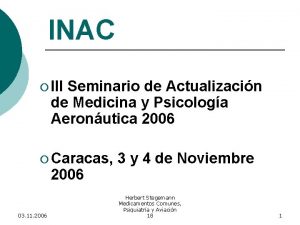Tech Services INAC Procedure for Addressing DWAs and





































































































- Slides: 101

Tech Services - INAC Procedure for Addressing DWAs and Other News OFNTSC Meeting Rama, Ontario, October 11, 2007 Presentation by: S. Crystal & J Steeves

News from INAC HQ PRESENTATION OUTLINE § Drinking Water Protocol & Provincial Regulations § § § Procedure for Addressing DWAs Wastewater Protocol Circuit Rider Training Program National Assessment Summary

News from INAC HQ Drinking Water Protocol & Provincial Regulations

Protocol for Safe Drinking Water in First Nations Communities The “Protocol for Safe Drinking Water in First Nations Communities” is a set of long-awaited, clear standards for the design, construction, operation, maintenance, and monitoring of First Nations drinking water systems.

Protocol for Safe Drinking Water in First Nations Communities The Protocol was developed over a period of 2+ years with input from: § INAC regions; § OGDs; and § First Nations water experts (including the OFNTSC and Alberta’s Technical Services Advisory Group).

Protocol for Safe Drinking Water in First Nations Communities INAC reviewed the regulatory frameworks of all Canadian jurisdictions to identify a set of best regulatory practices. This body of best practices was then "First Nation-ized" to be appropriate to the scale and context of drinking water systems in use in Canada's First Nations

Highlights of the DW Protocol Implementation As of March 21 st, 2006, as per the Minister's announcement, the Protocol was implemented immediately by INAC Regions and by now all First Nations should be complying with its requirements.

Highlights of the DW Protocol Application: The Protocol applies to any First Nation drinking water system that: – Is funded in whole or part by INAC; & – Serves five or more households (or a publicly-owned facility).

Highlights of the DW Protocol Design Requirements: Design standards for FN water systems will be as set out in: “Design Guidelines for First Nations Water Works”

Highlights of the DW Protocol Performance Requirements: Drinking water must meet the water quality criteria set out in the latest edition of Health Canada’s “Guidelines for Canadian Drinking Water Quality” (GCDWQ)

Highlights of the DW Protocol Monitoring Requirements: The Protocol specifies three types of monitoring: § Operational monitoring § QA/QC monitoring § Third party monitoring

Highlights of the DW Protocol Monitoring Requirements: Operational monitoring is conducted by the operator and includes daily and weekly water quality tests of: § Raw water § Treated water, and § Distribution system water.

Highlights of the DW Protocol Monitoring Requirements: (cont’d) Historically some First Nations have relied solely on weekly water quality testing (at the tap only) performed by Health Canada. Operators should undertake regular Operational monitoring.

Highlights of the DW Protocol Training & Certification: Operators must be trained and certified to the level specified by provincial operator certification requirements for their classification of system.

Highlights of the DW Protocol Record Keeping: Water system operators and managers must keep on file all records related to required water quality monitoring, operations, and system maintenance for a period of not less than 5 years.

Highlights of the DW Protocol Annual Inspections: Inspections to verify system performance must be completed annually by a qualified inspector as set out in: “Guide for Annual Inspections of First Nations Drinking Water Systems” (Appendix H of the Protocol)

Highlights of the DW Protocol Annual Inspections (cont’d): Annual inspection reports are a collaborative process involving all stakeholders (including the Circuit Rider Trainer) and concentrate on water system performance and whether the water is safe to drink.

Highlights of the DW Protocol Annual Inspections (cont’d): System performance will be assessed based on: § Water quality testing results (as provided by HC and FN); § Operational procedures; and § Operator certification level in relation to system classification.

Highlights of the DW Protocol Compliance First Nations need to meet the more stringent of either: § The Protocol’s requirements; or § Provincial standards

Highlights of the DW Protocol Compliance (cont’d) This means that if an element in a provincial standard (e. g. turbidity) is more stringent than the same element in the Protocol, then that higher objective should be adhered to in that region. The rest of the Protocol still applies.

Highlights of the DW Protocol Compliance (cont’d) It is not possible for a region or for a First Nation to opt out of the Protocol.

Highlights of the DW Protocol Compliance (cont’d) Compliance with the Protocol is part of the terms and conditions of all funding agreements between the Government of Canada and First Nations.

Protocol Implementation To date, implementation of the Drinking Water Protocol has been disappointing.

Protocol Implementation of the Protocol by INAC Regions began March 21 st, 2006, as per the Minister’s directive. Thus, by now (1 ½ years later) most First Nations should be complying with the Protocol’s requirements.

Protocol Implementation Unfortunately, many operators do not have a copy of the Protocol, or have not read it, or do not understand their responsibilities.

Protocol Implementation More action is needed to improve uptake of the Protocol by operators.

Protocol Implementation There are some basic questions that need to be answered: § What percentage of First Nations operators actually have a copy of the Protocol? § What percentage understand the Protocol’s requirements and comply with them?

Protocol for Safe Drinking Water in First Nations Communities The Protocol is a “living document” and will be refined continuously to reflect feedback from First Nations practitioners. The latest version of the Protocol can be found at INAC’s web site: http: //www. ainc-inac. gc. ca/H 2 O

First Nations Drinking Water and Provincial Regulations Why adopt provincial regulations? Compliance with the Protocol is achieved through terms and conditions of funding agreements between the Government of Canada and First Nations (i. e. : no laws exist to enforce compliance with the Protocol).

First Nations Drinking Water and Provincial Regulations Why adopt provincial regulations? The government does not consider this to be an effective way to ensure compliance or to foster accountability between Band Councils and their citizens.

First Nations Drinking Water and Provincial Regulations What might the government do? To provide First Nations residents with the same protection that is enjoyed by most Canadians, the government is considering enacting legislation that will apply provincial water regulations to First Nations water systems.

First Nations Drinking Water and Provincial Regulations What will this accomplish? The intention would be to provide First Nations with a regulatory regime that is enforced by laws, rather than terms of funding agreements.

First Nations Drinking Water and Provincial Regulations How would regulations be adopted? First Nations water systems would become subject to provincial regulations after they are adjusted to the context of First Nations communities. The requirements of the DW Protocol will continue on as a minimum baseline standard.

First Nations Drinking Water and Provincial Regulations How would regulations be enforced? Provincial regulations on reserve are expected to be enforced by provincial agencies.

First Nations Drinking Water and Provincial Regulations Will there be penalties? Yes. There will be both monetary penalties (fines) and punitive penalties (jail time) for non-compliance with provincial regulations.

First Nations Drinking Water and Provincial Regulations Will all Fist Nations be regulated? Yes. In provinces where the provincial regulatory regime is deemed inadequate, the Drinking Water Protocol will be the base level of standards upon which provincial regulations will be adjusted before adoption by INAC.

First Nations Drinking Water and Provincial Regulations When will this happen? The process of adapting and adopting provincial regulations for use in First Nations is expected to take 4 to 5 years. Implementation of the new regulations is expected to take an additional 3 to 5 years.

First Nations Drinking Water and Provincial Regulations And until then …. ? The Drinking Water Protocol will continue to apply in all First Nations across Canada until it is replaced (if ever) by provincial regulations.

News from INAC HQ PRESENTATION OUTLINE § Drinking Water Protocol and Provincial Regulations § Procedure for Addressing DWAs § § Wastewater Protocol Circuit Rider Training Program National Assessment Summary

News from INAC HQ Procedure for Addressing DWAs

Background on DWAs in First Nations Communities Problems with DWAs The number and the duration of Drinking Water Advisories (DWAs) in First Nations communities has become a chronic public safety problem in some First Nations.

Background on DWAs in First Nations Communities According to data from Health Canada, as of November 2, 2006, more than 100 DWAs were in effect in First Nations communities across Canada. Of these 100 DWAs: § 63% are more than 1 yr old § 45% are more than 2 yrs old § One DWA was in place for more than 21 years.

Background on DWAs in First Nations Communities In 2006, HC completed a survey on DWAs. The following are some conclusions of the study: § Drinking Water Advisories are ineffective: § If they are not fully understood; § If they are frequent, on-going, or excessively long-term. § If the causes of DWAs in First Nations communities are not addressed effectively, serious health problems can result.

Background on DWAs in First Nations Communities In 2005, the Drinking Water Advisory Working Group (also known as the DWAWG team) was formed to develop a procedure to help First Nations address their DWAs. The DWAWG team had members from: § Health Canada HQ and regions; § INAC HQ & regions; and § First Nations (including technical services providers like OFNTSC).

Background on DWAs in First Nations Communities The DWAWG has developed a procedure entitled: “Procedure for Addressing Drinking Water Advisories in First Nations Communities South of 60° (Procedure)” The Procedure is to be rolled out nation-wide this Fall at eight regional awareness sessions.

Background on DWAs in First Nations Communities The procedure will assist First Nations to address their DWAs more quickly by: § Clarifying roles & responsibilities; and § Developing community-based water team (CBWT).

Background on DWAs in First Nations Communities The DWAWG undertook an extensive process of obtaining feedback from stakeholders to complete the final draft of the Procedure. In July/August 2006, the draft Procedure was distributed to INAC regional managers for comment. HC also distributed the draft to its regions and selected First Nations for comments.

Background on DWAs in First Nations Communities Most (if not all) comments received were addressed by changes incorporated into the final Procedure. The Procedure will be a living document, regularly updated as needed.

Highlights of the Procedure Application The Procedure will apply to all INAC-funded First Nations drinking water systems where effective procedures to address DWAs do not already exist.

Highlights of the Procedure Basic Approach The Procedure is a step-by-step guide to help First Nations address the underlying causes of DWAs in their communities. The Procedure is intended for use by Chief and Council which will chair a new local group, called a Community-Based Water Team (CBWT), that will advise Chief and Council on how best to efficiently address a DWA.

Highlights of the Procedure Basic Approach: (cont’d) The main task of the CBWT is to advise Chief and Council and to help co-ordinate efforts to lift a DWA. When a DWA is issued, it is the responsibility of Chief and Council to activate and chair the CBWT and obtain its advice on lifting the DWA.

Highlights of the Procedure Membership of the CBWT Representatives from: § First Nations (Chief, Council, operator, …) § Tribal Councils, tech. services orgs. § INAC (capital and engineering) § HC (ex: EHO) § CRTP

Highlights of the Procedure Formation of the CBWT Chief and Council should recruit the membership for a CBWT well before a DWA is issued and train team members on how to use the new Procedure.

Highlights of the Procedure Formation of the CBWT Chief and Council should also: § Maintain a list of CBWT members; and § Organise a teleconference with the CBWT periodically to address issues that could affect the safety of the drinking water supply.

Steps to address a DWA Steps to follow The steps to be followed by Chief and Council and the CBWT to address a DWA issue are presented in the following flow chart …

Procedure to address DWAs Option 1 C&C address/lift DWA in 3 -4 days and advise HC and INAC. Option 2 Drinking Water Advisory Issued C&C or designate develop action plan C&C or designate submit action plan to INAC & HC for review * INAC & HC review action plan ** Action plan is complete? YES NO Option 3 C&C or designate activate CBWT to aid in development of action plan With advice from CBWT, C&C or designate develop action plan within 2 business days of DWA being issued. C&C or designate implement action plan and lift DWA * - To be developed within 2 business days of DWA being issued ** - To be reviewed and returned within 2 business days of receipt C&C or designate implement action plan and lift DWA

Option 1 C&C address/lift DWA in 3 -4 days and advise HC and INAC. Option 2 Drinking Water Advisory Issued C&C or designate develop action plan C&C or designate submit action plan to INAC & HC for review * INAC & HC review action plan ** Action plan is complete? YES NO Option 3 C&C or designate activate CBWT to aid in development of action plan With advice from CBWT, C&C or designate develop action plan within 2 business days of DWA being issued. C&C or designate implement action plan and lift DWA * - To be developed within 2 business days of DWA being issued ** - To be reviewed and returned within 2 business days of receipt C&C or designate implement action plan and lift DWA

Option 2 Option 1 C&C address/lift DWA in 3 -4 days and advise HC and INAC. Option 2 Drinking Water Advisory Issued C&C or designate develop action plan Option 3 C&C or designate activate CBWT to aid in development of action plan C&C or designate submit action plan to INAC & HC for review * INAC & HC review action plan ** With advice from CBWT, C&C or designate develop action plan within 2 business days of DWA being issued. Action plan is is plan complete? YES NO C&C or designate implement action plan and lift DWA * - To be developed within 2 business days of DWA being issued ** - To be reviewed and returned within 2 business days of receipt C&C or designate implement action plan and lift DWA

Option 3 Option 1 C&C address/lift DWA in 3 -4 days and advise HC and INAC. Option 2 Drinking Water Advisory Issued C&C or designate develop action plan C&C or designate submit action plan to INAC & HC for review * INAC & HC review action plan ** Action plan is complete? YES C&C or designate implement action plan and lift DWA NO Option 3 C&C or designate activate CBWT to aid in development of action plan With advice from CBWT, C&C or designate develop action plan within 2 business days of DWA being issued. C&C or designate implement action plan and lift DWA

Procedure to address DWAs Intervention (if necessary) Step 1 – INAC and HC approach Chief & Council to encourage that immediate action be taken to address the DWA situation. This will take care of most cases according to HC.

Procedure to address DWAs Intervention (if necessary) Step 2 – If Step 1 is unsuccessful and public health is at risk, INAC has the authority, as set out in terms and conditions of funding agreements with FNs, to take action to remedy the situation. This can include: § Developing an action plan § Activating the CBWT § Implementing the action plan

News from INAC HQ PRESENTATION OUTLINE § Drinking Water Protocol § Procedure for Addressing DWAs § Wastewater Protocol § Circuit Rider Training Program § National Assessment § Summary

News from INAC HQ Wastewater Protocol

Protocol for Treatment & Disposal of Wastewater in First Nations Communities Existing Wastewater Quality Standards All effluents discharged on Federal lands must meet the quality objectives set out in Environment Canada’s 1976 “Guidelines for Effluent Quality and Wastewater Treatment at Federal Establishments” Essentially these guidelines require at least secondary-level treatment for wastewater.

Protocol for Treatment & Disposal of Wastewater in First Nations Communities INAC’s Standard The 1976 EC Guidelines are INAC’s departmental standard for wastewater and apply to all INAC facilities and to First Nations wastewater systems.

Protocol for Treatment & Disposal of Wastewater in First Nations Communities New Wastewater Protocol INAC has now developed a draft protocol for the treatment and disposal of wastewater in First Nations communities.

Protocol for Treatment & Disposal of Wastewater in First Nations Communities Protocol Requirements The new wastewater protocol specifies requirements for: § Minimum treatment (1976 Guidelines) § Design and construction § Operations & maintenance § Monitoring § Record keeping, and reporting.

Protocol for Treatment & Disposal of Wastewater in First Nations Communities Review & Feedback The first draft of a new wastewater protocol has been sent out for stakeholder review and we are now awaiting comments: § INAC regions § Environment Canada § First Nations technical organisations (TSAG, OFNTSC).

Protocol for Treatment & Disposal of Wastewater in First Nations Communities Evolution of the Protocol The Protocol will be revised and refined to reflect all comments.

Protocol for Treatment & Disposal of Wastewater in First Nations Communities New Regulations Over the past two years, Environment Canada has been developing new regulations for Municipal Wastewater Effluent (MWWE) to be enabled under the Fisheries Act.

Protocol for Treatment & Disposal of Wastewater in First Nations Communities Purpose of the New Regulations The main purpose of the regulations is to ensure, Canada-wide, a harmonized minimum standard for MWWE discharges.

Protocol for Treatment & Disposal of Wastewater in First Nations Communities Canada-Wide Adoption Through the Canadian Council of Ministers of the Environment (CCME), the new Fisheries Act regulations, which will apply on and off reserves, will be duplicated in all provincial and territorial regulations that concern wastewater effluent.

Protocol for Treatment & Disposal of Wastewater in First Nations Communities No Big Changes The new regulations essentially propose a minimum standard of secondary-level treatment for wastewater. In other words, they are essentially the same as the 1976 Guidelines.

Protocol for Treatment & Disposal of Wastewater in First Nations Communities Consultation Environment Canada provided information to First Nations through various venues (AFN water forum, workshops). EC is also planning a consultation process with First Nations for the next couple of months.

Protocol for Treatment & Disposal of Wastewater in First Nations Communities Adoption of the New Regulations When Environment Canada’s finalises and adopts the new regulations, INAC will incorporate them into the Wastewater Protocol. Until then, the Protocol will continue to specify the 1976 Guidelines.

News from INAC HQ PRESENTATION OUTLINE § Drinking Water Protocol § Procedure for Addressing DWAs § Wastewater Protocol § Circuit Rider Training Program § National Assessment § Summary

News from INAC HQ Circuit Rider Training Program

Circuit Rider Training Program (CRTP) The Circuit Rider training Program has proven to be good value for money. In March 2007, INAC brought together Circuit Riders from across Canada to share ideas on how to improve the program. INAC is acting on these ideas.

Circuit Rider Training Program (CRTP) At the meeting, we also took a survey to get more information about how the Circuit Rider program is delivered in different areas. There were some interesting findings …

Circuit Rider Training Program (CRTP) Regions with full coverage and realistic work loads for CRTs, had the fewest DWAs and other problems.

Circuit Rider Training Program (CRTP) At the meeting, we also took a survey to get more information about how the Circuit Rider program is delivered in different areas. There were some interesting findings …

Circuit Rider Training Program (CRTP) INAC is acting on these findings: 1. Best practices being recommended for adoption by all regions. 2. Funding being increased. 3. Coverage being expanded.

News from INAC HQ PRESENTATION OUTLINE § § Drinking Water Protocol Procedure for Addressing DWAs Wastewater Protocol Circuit Rider training Program § National Assessment § Summary

News from INAC HQ National Assessment

National Assessment INAC is in the process of starting a national assessment of all First Nations drinking water and wastewater systems.

National Assessment To ensure consistency and comparability between regions, detailed terms of reference for the national assessment are being drafted now. It is expected that the assessment, which is to commence in the next 3 to 5 months, will take about 2 years to complete.

National Assessment The assessment will identify the risk levels for all systems as well as provide cost estimates to build or upgrade, operate, and maintain water and wastewater systems to meet Departmental standards.

National Assessment The assessment will also include a serviceability analysis (for publicand private-system residents).

News from INAC HQ PRESENTATION OUTLINE § § Drinking Water Protocol Procedure for Addressing DWAs Circuit Rider training Program National Assessment § Summary

News from INAC HQ Summary

To Summarise the Drinking Water Protocol The Protocol for Safe Drinking Water in First Nations Communities: 1. In effect since March, 2006 2. Required under the terms and conditions of funding agreements. 3. Needs ongoing feedback from water system operators.

To summarise the Procedure for Addressing DWAs The Procedure for Addressing DWAs: 1. INAC and HC are developing plans to implement the new procedure in each region. 2. INAC and HC regional representatives will need to meet with Chiefs & Councils to implement the new procedure by the end of this winter.

To Summarise the Wastewater Protocol The Protocol for Treatment & Disposal of Wastewater in First Nations Communities: 1. Currently uses on EC 1976 2. Will use new regulations when they are finalised

To summarise the Circuit Rider Training Program The CRTP: 1. Has proven to be one of INAC’s best investments 2. Funding is being increased so that the CRTP is expanded and sustained in the long-term.

To Summarise the National Assessment The National Assessment of First Nations water and wastewater systems: 1. Will begin in next fiscal year 2. Will require two years to complete and generate reports.

Progress to date under the FNWMS High-Risk Systems Reduction: § From 207 high-risk water systems in 2002, we are now down to only 97 high-risk systems this summer. § The minister’s objective now is to reduce the number of high-risk systems to 45 or fewer by the end of this year.

Progress to date under the FNWMS High- & Medium Risk Systems: Five risk factors are used to calculate the Overall Risk Score of a water system: § § § Source risk Design risk Operations & Maintenance Risk Operator risk Record keeping & reporting risk

Progress to date under the FNWMS High- & Medium Risk Systems: To calculate the overall score, a weight is assigned to each risk factor: § § § Source risk (10%) Design risk (30%) Operations & Maintenance Risk (30%) Operator risk (20%) Record keeping & reporting risk (10%)

Progress to date under the FNWMS High- & Medium Risk Systems:

Progress to date under the FNWMS High- & Medium Risk Systems:

News from INAC HQ Questions? Jim Steeves, P. Eng. Water Resources Engineer Infrastructure & Housing Directorate Indian & Northern Affairs Canada 10 Wellington St. , Gatineau, QC, K 1 A 0 H 4 Phone: (819) 994 -7226 E-mail: steevesj@inac. gc. ca
 Inac ciata
Inac ciata Flat addressing vs hierarchical addressing
Flat addressing vs hierarchical addressing High tech low tech
High tech low tech Gen-tech services
Gen-tech services Poly tech industrial services
Poly tech industrial services Ttu business services
Ttu business services Tech data cloud services
Tech data cloud services Formuö
Formuö Novell typiska drag
Novell typiska drag Nationell inriktning för artificiell intelligens
Nationell inriktning för artificiell intelligens Returpilarna
Returpilarna Shingelfrisyren
Shingelfrisyren En lathund för arbete med kontinuitetshantering
En lathund för arbete med kontinuitetshantering Underlag för särskild löneskatt på pensionskostnader
Underlag för särskild löneskatt på pensionskostnader Tidböcker
Tidböcker Anatomi organ reproduksi
Anatomi organ reproduksi Densitet vatten
Densitet vatten Datorkunskap för nybörjare
Datorkunskap för nybörjare Tack för att ni lyssnade bild
Tack för att ni lyssnade bild Debatt artikel mall
Debatt artikel mall Magnetsjukhus
Magnetsjukhus Nyckelkompetenser för livslångt lärande
Nyckelkompetenser för livslångt lärande Påbyggnader för flakfordon
Påbyggnader för flakfordon Vätsketryck formel
Vätsketryck formel Publik sektor
Publik sektor I gullregnens månad
I gullregnens månad Presentera för publik crossboss
Presentera för publik crossboss Teckenspråk minoritetsspråk argument
Teckenspråk minoritetsspråk argument Bat mitza
Bat mitza Treserva lathund
Treserva lathund Luftstrupen för medicinare
Luftstrupen för medicinare Bästa kameran för astrofoto
Bästa kameran för astrofoto Centrum för kunskap och säkerhet
Centrum för kunskap och säkerhet Byggprocessen steg för steg
Byggprocessen steg för steg Mat för unga idrottare
Mat för unga idrottare Verktyg för automatisering av utbetalningar
Verktyg för automatisering av utbetalningar Rutin för avvikelsehantering
Rutin för avvikelsehantering Smärtskolan kunskap för livet
Smärtskolan kunskap för livet Ministerstyre för och nackdelar
Ministerstyre för och nackdelar Tack för att ni har lyssnat
Tack för att ni har lyssnat Referat mall
Referat mall Redogör för vad psykologi är
Redogör för vad psykologi är Borstål, egenskaper
Borstål, egenskaper Atmosfr
Atmosfr Borra hål för knoppar
Borra hål för knoppar Vilken grundregel finns det för tronföljden i sverige?
Vilken grundregel finns det för tronföljden i sverige? Standardavvikelse formel
Standardavvikelse formel Tack för att ni har lyssnat
Tack för att ni har lyssnat Steg för steg rita
Steg för steg rita Verksamhetsanalys exempel
Verksamhetsanalys exempel Tobinskatten för och nackdelar
Tobinskatten för och nackdelar Blomman för dagen drog
Blomman för dagen drog Datumr
Datumr Egg för emanuel
Egg för emanuel Elektronik för barn
Elektronik för barn Klädsel i rom
Klädsel i rom Strategi för svensk viltförvaltning
Strategi för svensk viltförvaltning Kung som dog 1611
Kung som dog 1611 Humanitr
Humanitr Ro i rom pax
Ro i rom pax Tack för att ni lyssnade
Tack för att ni lyssnade Multiplikation med decimaltal uppgifter
Multiplikation med decimaltal uppgifter Versrader dikt
Versrader dikt Inköpsprocessen steg för steg
Inköpsprocessen steg för steg Fuktmätningar i betong enlig rbk
Fuktmätningar i betong enlig rbk Etik och ledarskap etisk kod för chefer
Etik och ledarskap etisk kod för chefer Skivepiteldysplasi
Skivepiteldysplasi Myndigheten för delaktighet
Myndigheten för delaktighet Frgar
Frgar Sju principer för tillitsbaserad styrning
Sju principer för tillitsbaserad styrning Läkarutlåtande för livränta
Läkarutlåtande för livränta Brant karttecken
Brant karttecken Gumman cirkel
Gumman cirkel Shivaiter
Shivaiter Mitos steg
Mitos steg Bris för vuxna
Bris för vuxna Big brother rösta
Big brother rösta Addressing concerns and earning commitment
Addressing concerns and earning commitment Network address block
Network address block Difference between classful and classless addressing
Difference between classful and classless addressing Addressing concerns and earning commitment
Addressing concerns and earning commitment Classless and classful
Classless and classful Classless addressing
Classless addressing Addressing competition and driving growth
Addressing competition and driving growth Subnetting supernetting and classless addressing
Subnetting supernetting and classless addressing Addressing competition and driving growth
Addressing competition and driving growth Acars message format
Acars message format Addressing mode of 8086
Addressing mode of 8086 Addressing modes of 8086 microprocessor
Addressing modes of 8086 microprocessor Addressing dyslexia toolkit
Addressing dyslexia toolkit Addressing mode in computer architecture
Addressing mode in computer architecture Hlt addressing mode
Hlt addressing mode Based indexed addressing mode example
Based indexed addressing mode example Protected mode memory addressing
Protected mode memory addressing Classful addressing
Classful addressing _tmain
_tmain Circular addressing mode
Circular addressing mode List the eight great ideas invented by computer architects
List the eight great ideas invented by computer architects Sic/xe nixbpe
Sic/xe nixbpe Classful addressing
Classful addressing Addressing modes in assembly language
Addressing modes in assembly language Addressing modes of 8085 microprocessor
Addressing modes of 8085 microprocessor













































































